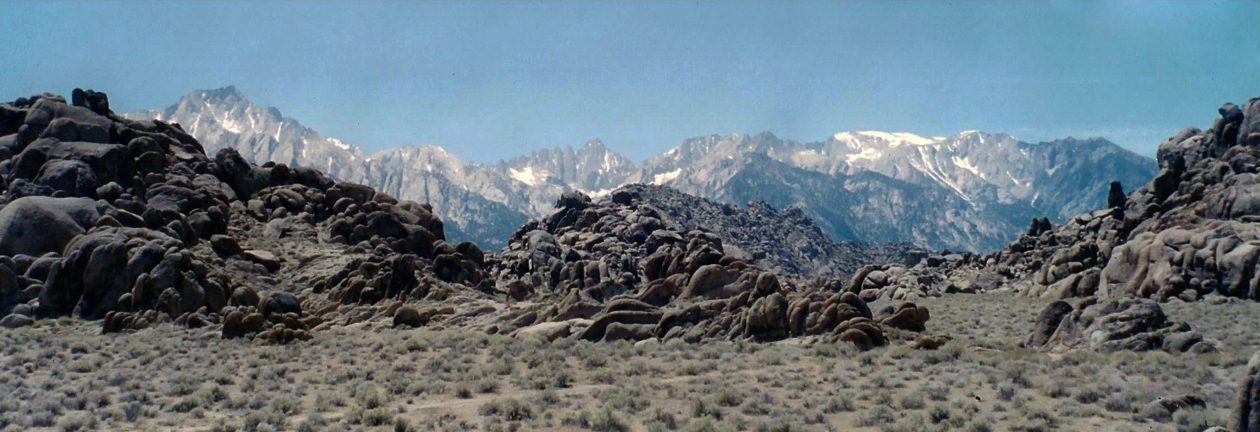Siem Reap, Cambodia
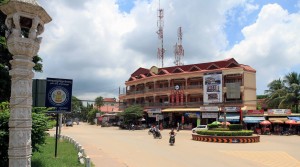
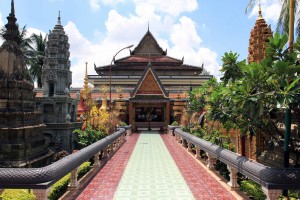
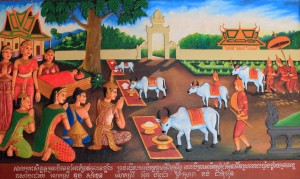
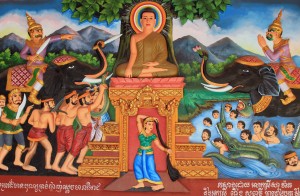
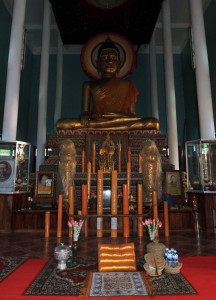
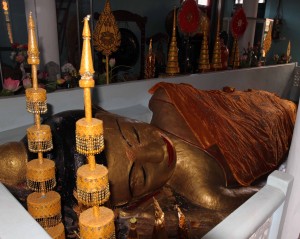
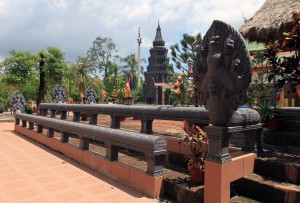
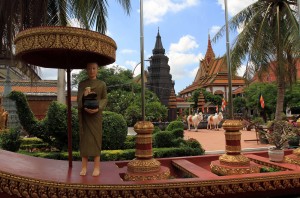
After sleeping in, I got ready today to see the sites around Siem Reap (saving Angkor for tomorrow). I set out to the Siem Reap River and then I followed it south on its eastern bank, trying to find Wat Bo (a Buddhist monastery); I had some trouble locating it as there were no signs, so I crossed back over the river and first went to Wat Preah Prom Rath instead. Wat Preah Prom Rath was built sometime in the late fifteenth or early sixteenth century by King Ang Chan to honor a highly revered monk known as Preah Ang Chang Han Hoy, who lived from 1358-1456 AD; Preah Ang Chang Han Hoy was a monk who would travel by boat to the then capital of Cambodia, Long Vek, to ask for food, when he returned he always came back with fresh food, thus earning his name, which means “monk with freshly cooked rice in his pot”. The main hall on the temple grounds is the ordination hall and there are many different colorful relief panels depicting the life of Buddha on the inside of the wall that surrounds the hall; inside the hall is a large seated Buddha statue and behind the seated Buddha, is a large reclining Buddha statue (partially made from a piece of the boat that Preah Ang Chang Han Hoy used) laying in a depression in the floor. There are also many other buildings and statues on the monastery grounds (one statue is of the revered monk on his boat), as well as balustrades with depictions of Nāga and Garuda at the ends (Garuda is the natural enemy of Nāga and I’m told that when depicted together, it actually stands for peace since they are in union; also, interestingly – according to legend – the Cambodian people are born from the Nāga King’s daughter who had intercourse with an Indian Brahmana). After walking around the temple monastery for some time, I then left and walked back east to try to find Wat Bo again.
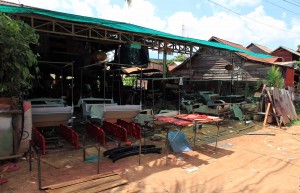
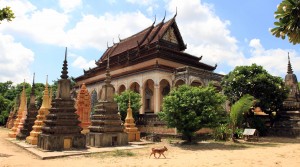
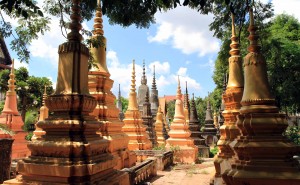
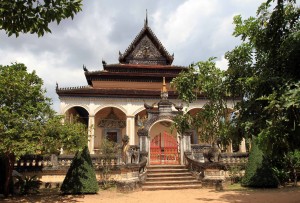
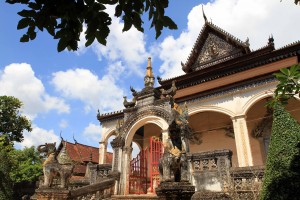
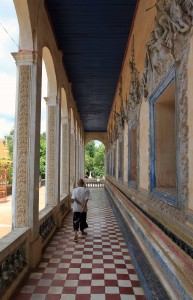
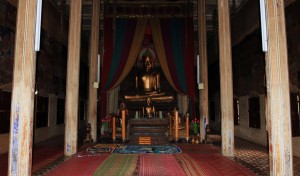
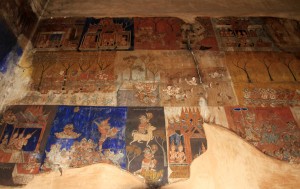
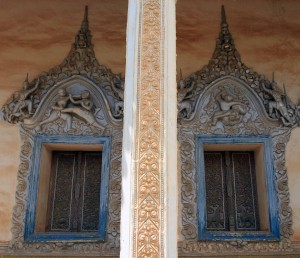
I wandered around some dusty dirt roads with street vendors and other odd shops here and there (one was a workshop producing tuk-tuk cabs . . . as if this city needed any more of those) before finally finding Wat Bo – it was further east, away from the river than I had thought. I entered in through one of the gates and came across an aged hall with many stupas used as monuments commemorating deceased monks surrounding it. I walked around the stupas and then the hall and an elderly man whom I think used to be a monk came up to me with keys in hand to open the hall up for me; we walked to the main entrance, he unlocked the door, we then walked in, and he proceeded to open a few window shutters up to allow light in; the walls and ceiling of the hall looked and smelled old, like an abandoned building constructed in the first half of the twentieth century; inside there was a giant seated Buddha statue with many smaller statues of varying size standing or sitting in front and behind; there were also frescoes painted on the walls inside the hall. I walked around the hall and captured much of it with my camera before thanking the elderly gentleman, making a donation, and then exiting the hall. I then looked around the rest of Wat Bo; there were students practicing on their musical instruments, a very old monk teaching a very young child in a pavilion, and a lot of construction going on (Wat Bo is in the process of adding several more buildings to its grounds). I then left the monastery and walked north.
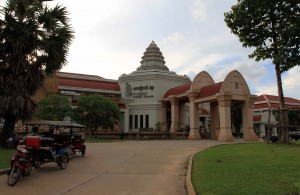
My next stop was the Angkor National Museum. I reached the museum, deposited my tripod and camera in a locker (they don’t allow bags or photography in this museum), paid my entrance fee, and then followed the signs to the exhibition rooms. The museum has many sculptures from Cambodia’s past and gives a thorough account of the ancient history in this land, from the Funan Kingdom (1st – 6th centuries), to the Chenla Kingdom (6th – 8th centuries), and finally to the Khmer Empire (9th – 15th centuries); “Funan” and “Chenla” were actually names given to the kingdoms by the Chinese at the time and there is no evidence of what these two kingdoms called themselves. I also learned about the rulers of the Khmer Empire, from Jayavarman II (the founder of Angkor), to Suryavarman II (who ordered Angkor Wat to be built), and finally to Jayavarman VII (who defeated Champa – an ancient kingdom based out of present-day Vietnam – and then went on to build Angkor Thom as his capital, as well as a network of roads with 121 rest-houses and 102 hospitals along these roads; he also introduced Mayahana Buddhism to the Khmer people and is considered the last great king of the Khmer Empire (he is still very popular today and the subject of much artwork); his goal was to turn Cambodia in to a paradise, in which the Khmer people would be the Tevada). In addition to learning about the history of Cambodia, I also gained a better understanding of the gods of Hinduism and Buddhism, and the mythologies associated with them. Finally, there were many exhibits showcasing the different architectural styles used in the ancient buildings, stylistic differences in art periods of the Khmer people, the production process of Batik paintings (this was a special exhibit designed to sell these Indonesian-style paintings), and an exhibit featuring sculptures and reliefs of Apsaras (beautiful, supernatural female spirits, also known as “celestial nymphs” and who are usually portrayed as dancing in the cosmos; they are found in both Hindu and Buddhist mythology). After exploring each of the museum’s exhibits, I then collected my things, and left, walking south to find a place to eat.
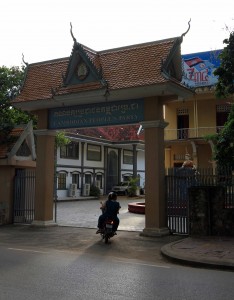
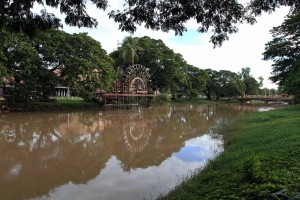
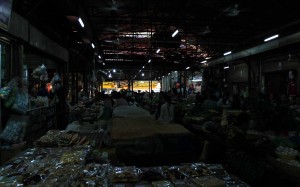
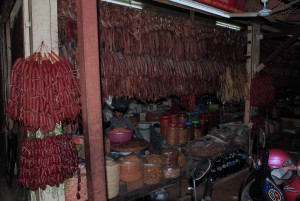
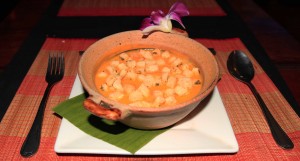
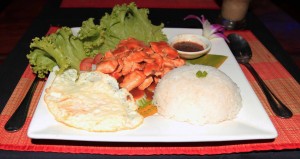
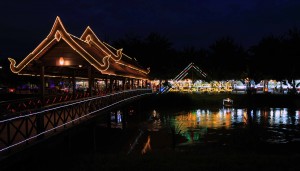
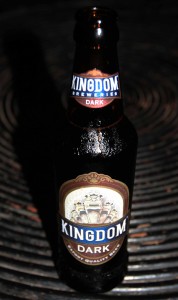
I walked south past the Cambodian People’s Party headquarters in Siem Reap and followed the Siem Reap River all the way down to the Central Market. I walked around the Central Market which had just about everything on sale (excluding large appliances) and then headed down to Pub Street and ended up eating at a restaurant next to where I ate at last night. For dinner I had Khmer Lok Lak (chicken marinated in oyster sauce cooked with Khmer wine) with steamed jasmine rice and a pumpkin cream soup with croutons. After dinner, I walked past the Central Market again and walked along the river at night before coming across the Angkor Market to buy some alcoholic pleasantries; I was surprised to see a wide selection of wine (European, Australian, South African, and South American), cheeses (the first real selection of cheeses I’ve come across in my travels!), and gourmet food (pâté, caviar, etc.) in this relatively small supermarket, but then I remembered Cambodia used to be a French colony and then it all made sense – evidently the French had imparted their high-class, haughty tastes to the Cambodian people prior to the end of their colonial rule. I ended up buying a bottle of Bordeaux wine, Irish cheddar cheese, and a Kingdom Dark beer (a locally produced beer featuring Nāga on the label). I then walked back to my hotel room, dropped off my purchased goods, and then walked to a nearby bicycle rental shop and rented a bike (for only one USD per day!) for tomorrow’s adventure to Angkor; I then returned to my hotel with my bike and then went up to my room where I drank my beer and then my wine whilst eating my cheese (like an apple). I then fell asleep.
